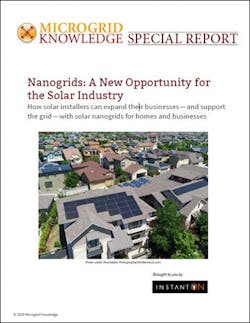Solar’s Transition to Nanogrids — and Why it’s Good for Solar Installers
This article wraps up a new special report series focused on the rise of solar nanogrids. Learn why nanogrids for solar installers make sense — and why this model gaining steam in the renewable energy industry.
Get the full report.
Savvy solar installers have their eye on the nanogrid market — the next phase in solar plus storage — as a potentially large market for their industry. The number of nanogrids in operation is small, but energy forecasters anticipate a significant increase over the next several years.
Watching how quickly the solar market grew is instructive for the future of nanogrids. In each of the last six years, solar has ranked as either the first or second fastest growing source of electricity. Today, the U.S. has enough solar capacity to power 13.1 million American homes, a number that the SEIA expects to double by 2024.
Energy storage, another key component of nanogrids, also is on a fast track. The U.S. deployed a record 311 MW and 777 MWh of energy storage in 2018, numbers that Wood Mackenzie sees doubling in 2019 and tripling in 2020.
The growth of the two technologies are symbiotic because they are increasingly paired into one system. The nanogrid is a system that benefits from this pairing. The nanogrid adds technology for islanding — the ability to disconnect from the grid during a power outage and generate energy independently.
Now, solar installers can provide homeowners not only with clean and dependable energy, but with longer guarantees of electric reliability, all of which nanogrids provide.
Nanogrids act as a new growth avenue for solar and storage. Navigant Research estimates the global revenue for solar plus storage nanogrids will rise from $1.2 billion in 2015 to $23.1 billion in 2024. Nanogrids for solar installers could mean big returns.
The increasing market in residential solar-plus-storage is mostly driven by consumers’ interest in resiliency. With more storms, floods and hurricanes, customers want to know their power can stay on 24/7. This is creating a new niche service for solar installers, and it adds to the value proposition of their product. Now, solar installers can provide homeowners not only with clean and dependable energy, but with longer guarantees of electric reliability, all of which nanogrids provide.
What’s more, nanogrids can provide environmental benefits by deploying more zero-emissions energy sources, making use of waste heat, reducing energy lost through transmission lines, helping manage power supply and demand, and improving grid resilience to extreme weather, all while helping solve grid challenges. Boosting the implementation of nanogrids yields advantages to the solar industry, homeowners, grid users and the environment — a win-win for all.
In this project for Veterans, delivering energy as a service, Instant ON eliminates risk for the customer in a model that shifts their investment out of their capital budget and into their operational budget. (Photo credit: flysnowfly/Shutterstock.com)
Nanogrids in the real world
Solar as a renewable resource is unpredictable in nature and hard to scale up and down in line with demand. When it’s centrally produced, it suffers from transportation inefficiencies. Most homes and businesses generating solar power locally lack the information and the control capabilities required to generate it effectively and efficiently.
Nanogrids in 37 new homes for US veterans
Instant ON is partnering with All American Homes to build a community featuring nanogrids in 37 new homes for U.S. military veterans in Perris, Calif. The project will employ a “home as a service” model that the developer hopes to replicate nationally.
What’s unique about this project is its use of a large energy storage system. Each home in the pilot project will have 5 kW of solar, 40 kWh of battery storage, an intelligent circuit panel and advanced microgrid management system. The community center will be equipped with a 1 MW battery powered by CHP system to provide additional resilience.
Hawaii’s affordable nanogrid project supports growth of solar, resilience, independence
To support the growth of solar, resilience, savings and independence in Hawaii, Instant ON is working with Myron Thompson, CEO of CoolXEnergy, past vice president of the Hawaii Solar Energy Association and past president of the Hawaii PV Coalition. The goal is to introduce a simple, affordable nanogrid solution that can provide all these benefits but also be technology and contractor agnostic, allowing for ease of deployment. This will empower more solar companies to progress toward Hawaii’s environmental goals.
See here to explore further examples of nanogrids working to make solar energy more predictable and reliable as a renewable energy resource.
And download the full report for free, “Nanogrids: A New Opportunity for the Solar Industry,” courtesy of Instant ON, to further explore the possibilities of solar nanogrids.







